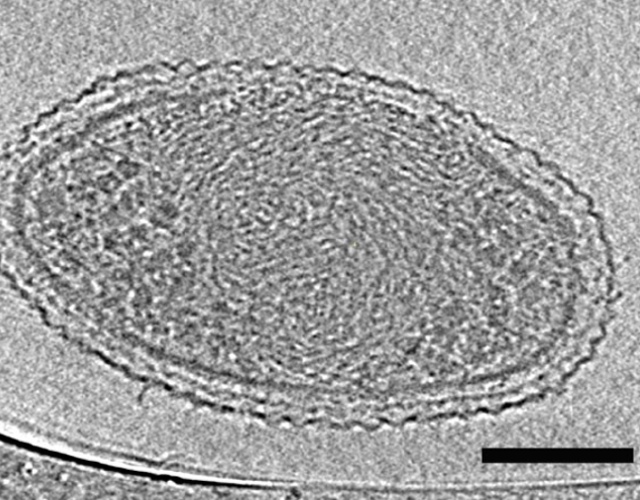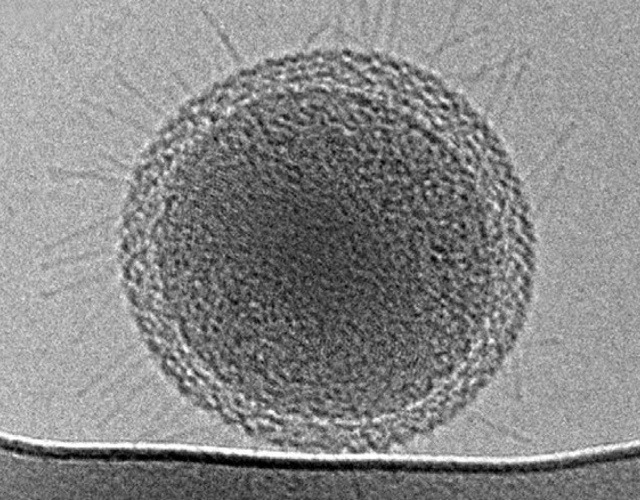In 1665, Robert Hooke published his influential book Micrographia, which contains detailed illustrations of specimens Hooke had observed under microscopes. Fascinated by the invisible world revealed in its pages, the public enthusiastically embraced Hooke's research, and inaugurated Micrographia as the first science bestseller in history.Now, 350 years later, scientists based out of Berkeley Laboratory have taken the first photographs of an even more exotic universe—life at its absolute smallest. In a paper published yesterday in Nature Communications, the Berkeley team unveiled images and video of mysterious "ultra-small" bacteria, which have an average volume of 0.009 cubic-microns. That is so astonishingly tiny that about 150,000 of these microbes could fit on the tip of a hair strand.Electron microscope images of ultra-small bacteria in motion. Credit: Berkeley Lab/KeSimpulan/YouTube.According to the study's authors, that's about as small as life can possibly get while still maintaining all the cellular essentials. Photographing these diminutive creatures is an accomplishment in itself, but the real thrill is how utterly alien life at this scale is, despite the fact that this bacteria is very common in groundwater.Much like Hooke's Micrographia, the research has opened a new window into a world that exists all around us, but that we have never seen up close before. It may even reignite the debate over whether some meteorites are embedded with preserved lifeforms, an idea that has been dismissed by some on the assumption that life on the nanoscale is improbable. At the very least, the new findings are a significant development in our understanding of the structural makeup and survival strategies of these tiny lifeforms."These newly described ultra-small bacteria are an example of a subset of the microbial life on earth that we know almost nothing about," said study co-author Jill Banfield in a Berkeley Lab statement. "They're enigmatic," she added. "These bacteria are detected in many environments and they probably play important roles in microbial communities and ecosystems. But we don't yet fully understand what these ultra-small bacteria do."The sampled bacteria were mostly from three phylum groups called WWE3, OP11, and OD1, measuring about 200 to 300 nanometers across. The Berkeley team was able to isolate these tiny specimens from groundwater collected in Colorado essentially by passing it through smaller and smaller sieves until it reached the filtration level of sterilized water.Though this process weeded out larger classes of microbes, it couldn't catch such small bacteria, giving the researchers a healthy sample size to study. The team used both 2D and 3D cryogenic transmission electron microscopy to capture the basic structure and active cell division occurring in the bacterial specimens. In other words, they preserved the organisms by freezing them, then shot electron beams at the samples to produce exquisite impressions of their natural processes.One of the interesting initial observations was that some of the bacterial cells have stringy limbs called pili, that appear to be lifelines to other individuals. Because these microbes are so much smaller than more familiar phylums, they also seem to be less robust, and probably increase their survival odds by pooling resources with their neighbors when necessary.
"They're enigmatic," she added. "These bacteria are detected in many environments and they probably play important roles in microbial communities and ecosystems. But we don't yet fully understand what these ultra-small bacteria do."The sampled bacteria were mostly from three phylum groups called WWE3, OP11, and OD1, measuring about 200 to 300 nanometers across. The Berkeley team was able to isolate these tiny specimens from groundwater collected in Colorado essentially by passing it through smaller and smaller sieves until it reached the filtration level of sterilized water.Though this process weeded out larger classes of microbes, it couldn't catch such small bacteria, giving the researchers a healthy sample size to study. The team used both 2D and 3D cryogenic transmission electron microscopy to capture the basic structure and active cell division occurring in the bacterial specimens. In other words, they preserved the organisms by freezing them, then shot electron beams at the samples to produce exquisite impressions of their natural processes.One of the interesting initial observations was that some of the bacterial cells have stringy limbs called pili, that appear to be lifelines to other individuals. Because these microbes are so much smaller than more familiar phylums, they also seem to be less robust, and probably increase their survival odds by pooling resources with their neighbors when necessary. "There isn't a consensus over how small a free-living organism can be, and what the space optimization strategies may be for a cell at the lower size limit for life," lead author and microbial ecologist Birgit Luef explained in the statement. "Our research is a significant step in characterizing the size, shape, and internal structure of ultra-small cells."When Hooke first revealed the diversity of life at the microscale, it revolutionized science and captivated the public. Perhaps these new insights into life at the nanoscale will usher in a another paradigm shift about the biological richness that lies beyond the reach of optical microscopes.
"There isn't a consensus over how small a free-living organism can be, and what the space optimization strategies may be for a cell at the lower size limit for life," lead author and microbial ecologist Birgit Luef explained in the statement. "Our research is a significant step in characterizing the size, shape, and internal structure of ultra-small cells."When Hooke first revealed the diversity of life at the microscale, it revolutionized science and captivated the public. Perhaps these new insights into life at the nanoscale will usher in a another paradigm shift about the biological richness that lies beyond the reach of optical microscopes.
Advertisement
Advertisement
